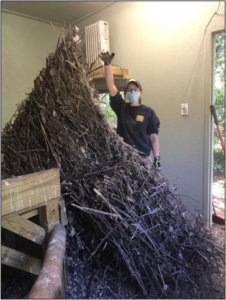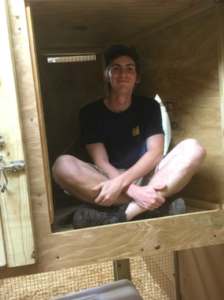Bird Breeding Season: Nesting
Hi everyone! My name is Lauren Wilson and I am the Associate Curator of Birds here at Zoo Atlanta. I’m so excited to share the ins and outs of the Bird Department’s breeding season with you over the next few weeks. The Bird Team works hard all year round, but especially during the breeding season to ensure all our birds at Zoo Atlanta have the opportunity to thrive.
We have over 220 individual birds at Zoo Atlanta representing over 55 species. Each species has its own breeding strategy, so each species requires a different type of nest site to be reproductively successful. Generally, the birds at Zoo Atlanta utilize six types of nests: cup, platform, scrape, mound, woven, and cavity. And, as if that’s not complicated enough, each species will use a variety of nesting material. Let’s look at each nesting strategy more closely!
Cup nesters are birds that build usually small, cup-shaped nests to lay their eggs. You may have seen some native birds build cup nests, such as American robins and northern cardinals. Here at Zoo Atlanta, our cup nesters include red-capped cardinals, blue-crowned laughingthrush, and snowy-headed robin chats. While all our aviaries provide a variety of trees and shrubs for cup nesters to build their nests in, sometimes they still can’t find the exact right spot, so we give them a little help by providing starter nests. These might simply be a small platform made of 1” x 1” mesh or a small mesh cup to give the birds a foundation to build their own nests. Sometimes, if they need more cover to feel secure, we’ll give them small, open-fronted boxes to build their cups inside or we’ll put up additional, usually fake, leaves around their nest sites.
Platform nesters utilize completely flat, square or rectangular spaces to build their nests. Here at Zoo Atlanta, our platform nesters include all our pigeon (e.g., speckled pigeon, pied imperial pigeon, Bruce’s green pigeon etc.) and turaco (e.g., violaceous, western plantain-eater) species, sunbittern, and tawny frogmouth. We construct platforms from wood and 1”x 1” mesh and we line them with shelf liner, just like you would purchase for your kitchen shelves, to provide some extra cushion for the eggs and to prevent future chicks from slipping out the mesh bottom. The trick with platform nesters is getting the size of the platform right and making sure the platform is level. If either of these is incorrect, we risk the birds not incubating the eggs correctly. Aviculturists have a saying that pigeons “build nests with two sticks and a prayer,” so while some pairs build exceptional nests, we need to set them up in case they go with the two-stick method!

At this point, I simply must mention our hooded vultures, lappet-faced vultures, and hamerkops. These birds utilize platforms in completely different ways from the traditional platform nesters I just mentioned. What I mean is that we provide our vultures and hamerkops with platforms, but they are significantly larger than the birds themselves and they build exceptional nests. Lappet-faced vulture nests can be 4-8 feet wide and 1-3 feet deep. Hamerkop nests can be 4 feet wide, support the weight of a human being, and have a tunnel inside that leads to a chamber big enough for parents and chicks. It takes A LOT of sticks for us to keep up with these intense nest builders!
Scrape nesters are by far the easiest. These species, which include our masked lapwings and spotted dikkops, simply make a small indentation on the ground. The keepers don’t have to provide these species with any nests or cover but, and this is a big BUT, they do have to look out and make sure to not step on the eggs when entering their habitats! Scrape nesters are not only incredibly defensive of their nest sites but have extremely camouflaged eggs, well, at least to mammals. Some new research suggests that birds see longer wavelengths than mammals and may even be able to perceive UV lighting. When you shine a UV light onto ground nesters’ eggs, they show up clearly so they may only be camouflaged from predators (mammals) and not birds (parents). This also helps the parents find their eggs. How cool is that?!
Mound nesters build tall cone or bell-shaped structures on the ground. Some species bury their eggs in their mound nests, but Chilean flamingos lay their eggs right on top! The secret to a successful Chilean flamingo breeding season is making the perfect mud. Every year we work with our Horticulture Department to procure up to 5,000 pounds of clay. The keepers then mix this clay by hand with the mud that is already in the habitat to produce a substrate that is the right consistency for the birds to build long-lasting mounds. Each day the Bird Team hand-turns and waters this mud to ensure the birds can manipulate it how they see fit. Sometimes we get our hands even dirtier and build a few mounds of our own that the birds quickly take over and finish.
Woven nests are made by weaver birds, and we have two species: white-headed buffalo and taveta. White-headed buffalo weavers push together pliable sticks and twigs to build their nests, whereas the taveta weavers, a much smaller species, weave grasses and leaves together. Both build round-shaped nests that contain a chamber inside for the eggs. The white-headed buffalo weaver nest can have multiple tunnels and chambers lined with soft material such as feathers. They typically use thorny or prickly sticks on the outside of their nests to deter predators.

Cavity nesters typically lay their eggs in a chamber hollowed out of a dead tree. You may have seen some native cavity nesters such as barred owls and any of the woodpecker species. Here at Zoo Atlanta, our cavity nesters include the hornbill species, starling species, and the green woodhoopoes. So how do we replicate dead trees? With a box, of course! The Bird Team builds nest boxes to fit each species. Specifications such as length, width, hole diameter, and substrate must all be taken into consideration. The placement of the nest box and coverage around the entry hole are also important. For some species an empty nest box is enough for them to build their nests in. For others, excavating their own cavity is an important part of their breeding cycle, so we simulate this by stuffing the box full of wood shavings or other material that they can pull out on their own. My favorite cavity nester is the rhinoceros hornbill. They not only excavate their own cavity but seal the female inside of it to lay the eggs, incubate the eggs, and raise the chicks until fledging. We have to provide them with mud, overly ripe fruit such as bananas, and sticky fruits such as figs and avocado so they can create this seal. Then it is up to the male to provide for the female and chicks until they break out of their cavity months later!
Finally, we cannot talk about nests without talking about nesting material. Each species, and sometimes each individual pair, utilizes different nesting material. What’s more is they often use one type of material to build the foundation of their nest and another type to line their nests. So, not only do the keepers need to know what each pair needs to build their nests, they need to know their preferences, and they need to constantly provide it. The keepers are so observant that they can usually tell when a pair is going to lay eggs based on what nesting material they are using. Cavity and cup nesters use a combination of coir fiber, sphagnum moss, sticks and twigs, raffia, wood wool, wood shavings, and feathers. Mound nesters use that perfect mud I described earlier. Scrape nesters are, again, easy and use nothing! Platform nesters and weavers utilize sticks, twigs, and grasses. Platform nest sticks are usually stiffer, whereas weavers need pliable sticks and grasses that can be manipulated easily by the birds. You’ll often see the Bird Team roaming around the Zoo, picking up nesting material, while exclaiming “that’s a good weaver stick!” or “no, we need more than that for the hamerkop!” or “the hooded vultures are using honeysuckle now, not bamboo!”
The breeding season is one of the busiest albeit one of the most rewarding times of year for the Bird Team. I hope that when you visit the Zoo next you take a minute to locate the nests, find the stashes of nesting material, and watch the birds display all the natural behaviors associated with breeding. I also hope you have a greater appreciation for the keepers who are working so hard so the birds can thrive!
Lauren Wilson
Associate Curator of Birds

Connect With Your Wild Side #onlyzooatl